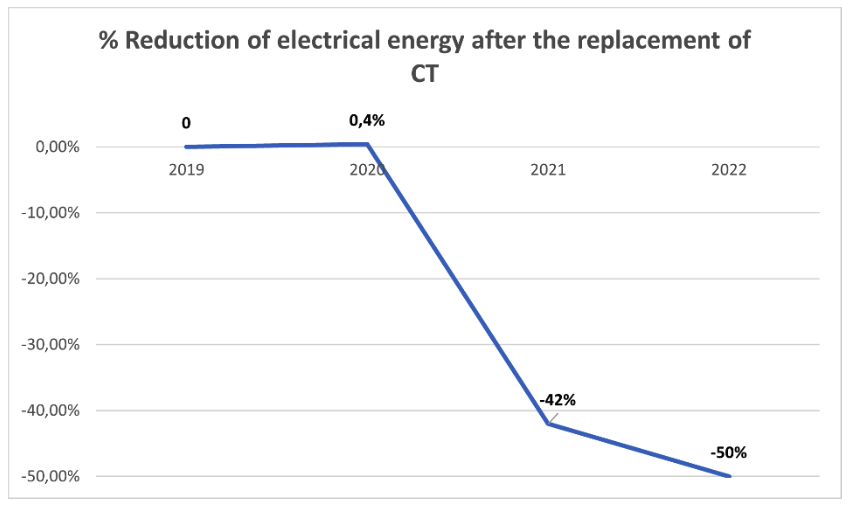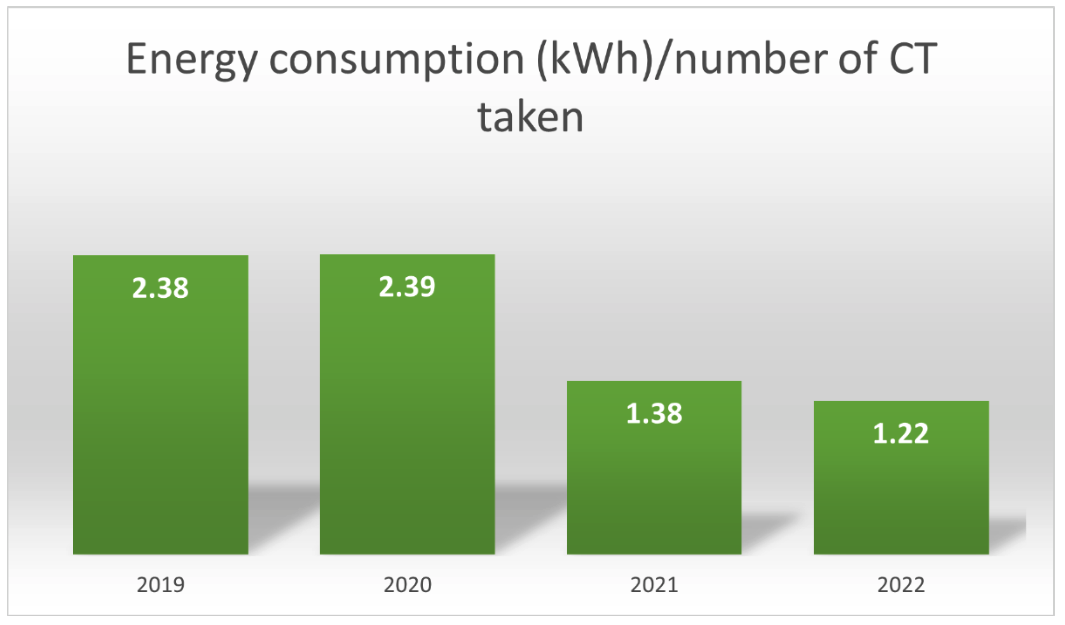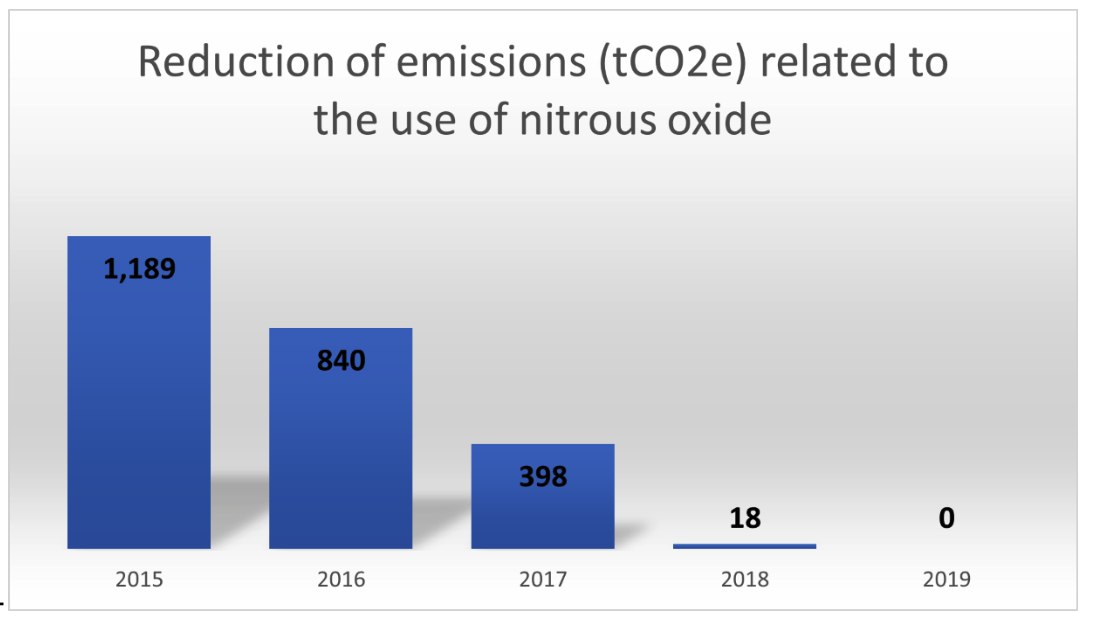From quitting nitrous oxide to replacing old equipment, hospital strives for ISO 50001 certification & energy efficiency
Transplant Hospital Euryclides de Jesus Zerbini, Brazil
Case study summary
This study includes actions to reduce greenhouse gas emissions, such as eliminating the use of nitrous oxide as an anesthetic gas, reducing energy consumption with the actions implemented to achieve ISO 50001 certification, and replacing a computed tomography machine.
Demographic information
- City: Sao Paulo
- State/province/region: Sao Paulo
- Country: Brazil
- Type of institution: public hospital specialized in organ and tissue transplants, national reference in neurosurgery and cerebral vascular microsurgery, largest national center in hematology and onco-hematology, world's largest center for the treatment of complex kidney stones, and the largest center in Latin America for the treatment of benign prostatic hyperplasia.
- Number of full-time staff: 220
- Number of part-time staff: 923
- Number of beds: 153
- Patient population served annually
- 129,947 patients served annually (total of inpatient and outpatient)
- Geographic area served: 95,833.64 mi²
The issue
This hospital is a part of Associação Paulista para o Desenvolvimento da Medicina (SPDM). SPDM is a social health organization, and it has the mission of offering services of excellence and high standards according to the principles of the United Health System or Sistema Único de Saúde in Portuguese (SUS), a public service provided without any cost to Brazilian citizens. The need to implement these projects arose from the strategic planning of the board of directors and their concern regarding the environmental impacts of the hospital’s activities and energy performance in relation to other social health organizations. The actions to improve energy performance and reduce environmental impacts were also motivated by the opportunity to reduce costs with electricity, fuels, and nitrous oxide, allowing these savings to be used to provide more individuals access to medical care.
Hospital goal
Reduce 20% of greenhouse gas emissions; reduce 8% of the consumption of electricity, natural gas, and diesel oil; improve energy performance; reduce the environmental impact of hospital activities; promote affirmative action in support of the sustainable development goals.

The ISO 50001 certification is the international recognition of the Hospital's efforts to save energy. All energy savings are reversed in a greater number of medical assistance. The money is used to provide medical care for those in need.
Sustainability strategy implemented
Interventions were selected to meet the requirements of the ISO 50001 standard in order to improve energy performance. The data evaluated included greenhouse gas emissions and consumption of electricity, natural gas, and diesel oil. In addition, the hospital acquired energy-efficient equipment, replaced an old computed tomography machine, gradually replaced air conditioners using R22 gas, and eliminated the use of nitrous oxide in anesthesia.
Implementation process
The hospital’s management, environmental technician, health technologist, anesthesiologists, and maintenance engineer were actively involved in the implementation stages, and all employees were made aware of the initiative and collaborated within their respective departments. The technical team managed the collection of data, risks, opportunities, changes, and operations; however, the active participation and support of the board of directors was essential to achieve results and for the decision-making process. Continuous training and education were conducted on sustainability, rational use of nitrous oxide in anesthesia machines, rational use of equipment that uses a significant amount of energy, and internal audits. Environmental management, clinical engineering, maintenance engineering, radiology, information technology, and the board of directors were involved. The changes were fully implemented without conducting pilots in a timeframe ranging from one (energy performance) to three years (nitrous oxide). The main change was felt by the anesthesia team, which had more resistant stakeholders and needed to change its processes.
Tracking progress
To track progress we used internal monitoring tools, telemetry, and the GHG protocol. Stipulated goals were to reduce 100% of the use of nitrous oxide, reduce 20% of energy consumption/CT, and reduce 8% of the hospital's overall energy consumption. AIl goals were achieved with excellence. In 2015 the consumption of nitrous oxide was 15.1 kg/day, in 2019 the consumption was zero; in 2019 2.38 kWh/CT were consumed, in 2022 it was 1.22 KWh/CT, with a 48% reduction in consumption/exam; and in 2017, total energy consumption was 3,404 MWh/year, while in 2022 it was 2,894 MWh/year, with a reduction of 15%.
Progress achieved
The implementation process began in 2015, with the hospital's affiliation to the Global Green and Healthy Hospitals Network and the completion of a GHG inventory. From 2016 to 2019, actions were taken to eliminate the use of nitrous oxide. Actions to reduce energy consumption started in 2017, and the computed tomography machine was replaced in 2021. With the implementation of all actions, 2,122 MWh of energy were saved from 2017 to 2022, with an average reduction of 424 MWh/year. As for emissions, from 2015 to 2021 the hospital's tCO₂e emissions reduced by 67%, from 1644 tCO₂e/year in 2015 to 545 tCO₂e/year in 2021. The drastic reduction in consumption and emissions brought financial benefits and earned several awards for the hospital.
Figure 1 - Percent reduction of electrical energy after the replacement of the computed tomography machine

Figure 2 - Emissions in metric tons of CO2 equivalent (tCO2e)

Figure 3 - Energy consumption (kWh) per the number of computed tomography machine uses

Figure 4 - Reduction of emissions (tCO2e) related to the use of nitrous oxide

Figure 5 - Reduction of overall energy consumption

Between 2017 and 2019, there was an estimated energy cost savings (electrical energy, natural gas, and diesel oil), of approximately USD 20.000,00 per year and cost savings from nitrous oxide reduction of USD 15.458,18 per year.
Challenges and lessons learned
The main challenge was to train and raise awareness of 100% of employees using strategies to increase their engagement. The main lesson is the need for top management's commitment because without their support it would not be possible to achieve the results we have demonstrated. Another essential point is to carry out an analysis of which equipment or emissions have the greatest impact and create actions to attack these problems to obtain significant results. In the case of the hospital, these actions involved nitrous oxide, computed tomography machine, air conditioning, computers, printers, and lighting.
Next steps
We have two goals to achieve: the reduction of natural gas consumption to improve energy performance and reduce emissions; and the expansion of telemetry, to improve the monitoring of electricity and natural gas consumption through real-time analysis of consumption. Some results have already been published through the Healthy Hospitals Project and the Clean Energy Ministerial.
